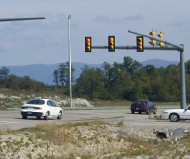5/21/2015
Virginia Report Finds Female Drivers Need Longer Yellow TimesVirginia Department of Transportation funded report that confirms the link between short yellow times and red light running.

The argument over whether current engineering practices produce yellow times that are too short has raged for more than a decade. Recent experience in Florida has shown that adding an extra 1.5 seconds to the commonly accepted minimum standard reduced violations by over 90 percent. A 2011 study funded by the Virginia Department of Transportation provided further evidence that the differences between drivers may account for the need for longer yellow durations.
A team of researchers at Virginia Center for Transportation Innovation and Research set out to monitor how drivers react to a changing traffic signal in a controlled environment. Two dozen volunteers were put in a GPS-monitored Chevy Impala on a 2.2 mile test course that included a computer-controlled intersection signal that allowed for precise measurements of timing and conditions. Researchers drove in other vehicles to simulate various traffic situations while the test subjects made more than 3,000 approaches to a changing signal.
The goal was to determine how best to avoid the dilemma zone. This is the point at which a driver approaching a intersection with the signal changing from green to yellow can neither stop safely nor proceed through the intersection without running the red light. Groups such as the National Motorists Association believe cities that use red light cameras have a financial incentive to maintain inadequate yellow times.
"It appears that the red-light runners did not violate the red light intentionally," the researchers observed. "Instead they appeared to misjudge their stop-run decision."
Engineers calculate yellow time based on an estimate of several factors. One factor is the "perception reaction time" or PRT, which is a measure of how long it takes a typical driver to decide whether to stop or go when the light changes. Current practice assumes this to be one second. Another is the deceleration level, which is a measure of how fast a typical driver will come to a stop (i.e., how hard he will hit the brake pedal). The Virginia study measured these factors directly and found significant variation.
"Driver PRT is higher for female and older drivers (60+ age group) compared to younger male drivers," the report concluded. "The PRT is larger for vehicles traveling along an upgrade section given that the driver is typically accelerating when the yellow indication is initiated. Driver PRTs are typically higher if they are following a vehicle that runs a yellow light."
Drivers who were not willing to slam the brakes hard were more likely to find themselves caught in the dilemma zone. This varied among demographic groups.
"The figure demonstrates that, in general, female drivers need longer yellow times compared to male drivers," the report found. "In addition, the age slightly affects the required yellow time, where older drivers need slightly longer yellow times when compared to younger drivers. The extreme comparison here could arise from comparing an intersection with a majority of old female drivers to another intersection with majority of young male drivers."
The researchers found picking a single reaction and deceleration time to calculate signal timing was overly simplistic and suggested more sophisticated algorithms could be used.
"The current approach fails to account for variations between different drivers approaching the same intersection at the onset of yellow," the report concluded. "These variations include variations in each driver's PRT and deceleration level."
The report created a computer model that simulated 100,000 motorists driving through a theoretical intersection that would have a 4.3 second yellow under standard engineering practices. The researchers suggested that yellow should be at least 4.5 seconds to account for the needs of 85 percent of motorists.
"The recommended yellow time corresponds to only a 12.6 percentile, which means that most of the drivers will encounter a yellow time that is shorter than what they really needed; i.e., they will be trapped in a dilemma zone," the report concluded.
The study created a chart (page 52) that allows engineers to select a yellow time for a given intersection speed and grade and essentially select how many red light runners they wish to create (or drivers who have to slam on the brakes). For example, at a 45 MPH intersection, half of drivers will hit a dilemma zone if the yellow is 2.9 seconds, but 99.9 percent will clear the intersection safely at 5.3 seconds.
After the report was published, the Virginia Department of Transportation ordered an increase in minimum yellow time of 0.5 seconds. A copy of the report is available in a 2.4mb PDF file at the source link below.


